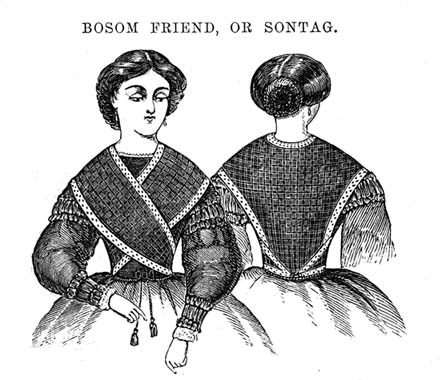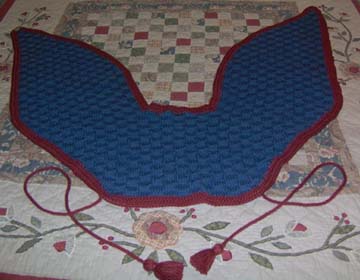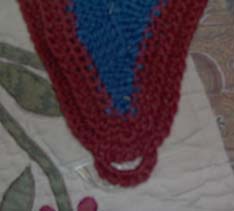

Materials.- Three and a half ounces crimson double zephyr, two and a half ounces white, half an ounce black, small bone or wooden needles.
CAST on thirty-five stitches, knit five stitches forwards and five backwards, thus forming the blocks; knit five lines in this way, widening one stitch at the commencement of each line. Knit the second row of blocks alternate with the first; knit eighteen blocks, then divide the blocks so that five are left in the middle and an equal number on each side. Bind off the five middle blocks, and knit up one front, narrowing one stitch on the inside every fourth line for six blocks; narrow every other line for the next six blocks; then narrow every line till you come to a point. For the border, cast on twelve stitches, knit plain; for the neck, ten stitches in width. The spots are darned on with black, in imitation of ermine.
A loop is put on one end, in front, and a button on the other, it crossed over and buttoned at the back; the back is fastened to a cord and tassels passing round the waist and tied in front.
 [Modern instructions are in regular type and additional translator's note are in italics.]
The size given here is the same as the original pattern, which tends to run small. I have found that increasing the number of stitches will take this to a medium size, which tends to fit the majority of people. Those adjustments are given in parentheses after the original number. If you need to make further adjustments, do so at these points. Otherwise, the materials list and instructions have just been translated, and not changed in any way. The completed sontag spread flat on a quilt is shown in the picture to the left.
[Modern instructions are in regular type and additional translator's note are in italics.]
The size given here is the same as the original pattern, which tends to run small. I have found that increasing the number of stitches will take this to a medium size, which tends to fit the majority of people. Those adjustments are given in parentheses after the original number. If you need to make further adjustments, do so at these points. Otherwise, the materials list and instructions have just been translated, and not changed in any way. The completed sontag spread flat on a quilt is shown in the picture to the left.
Materials: Approximately 500 yards crimson sport or DK weight wool; 200 yards white, half an ounce black. Size 7 or 8 needles (depending on wool used)
Cast on 35 (55) stitches, knit five stitches, then purl five stitches, thus forming the blocks. Knit five rows in this way, increasing one stitch at the beginning of each row. Knit the second row of blocks alternate with the first; knit until you have eighteen alternating blocks, which forms the back, then divide the blocks so that five are left in the middle, and an equal number on each side. Bind off the five middle blocks (this is for the neck), and place one side on stitch holders to work later. Continue in the pattern on each side of the front, working separately, decreasing one stitch on the inside every fourth line for six blocks; decrease every other line for the next six blocks; then decrease every line until you come to a point. Remember to always do the decreases on the inside.
If you want the sontag a bit longer and wider on the shoulders, then continue in the pattern after binding off the next section without decreasing for 3 (9) rows before beginning the decreases. The illustration included is done in this fashion.
For the border, cast on twelve stitches, knit in garter stitch around the outside, and back up the front.; however, for the neck area, decrease this border to ten stitches in width. The spots are darned on with black, in imitation of ermine, looking similar to this: \|/
 The border may be worked as described, which is following the original pattern, or use a double crochet border (2 or more rounds) and then darn in the spots if desired. The one I am showing simply has a double crochet border (see picture on right). You may also use a shell edge, as I have seen this on originals as well.
The border may be worked as described, which is following the original pattern, or use a double crochet border (2 or more rounds) and then darn in the spots if desired. The one I am showing simply has a double crochet border (see picture on right). You may also use a shell edge, as I have seen this on originals as well.
A loop is put on one end, in front, and the button on the other. It is crossed over and buttoned at the back; the back is fastened to a cord, and tassels passing round the waist and tied in the front.
You may create a cord by either knitting a modern I-cord, which, in appearance, looks like a cord made on a lucet, or by crocheting a cord, and then attaching it.